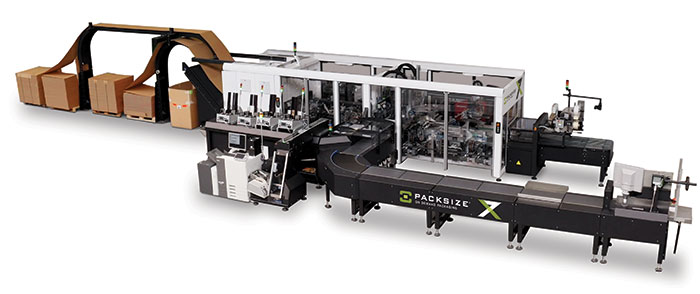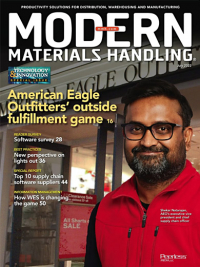A new perspective on lights out
While there aren’t too many facilities without a human workforce, lights out continues to gain acceptance in operational pockets with the help of advanced automation.
It’s such a great couple of words: Lights Out.
Whether you’re reading them for the first time or the 50th, you know exactly what they mean. No need for lights on the shop or warehouse floor because all processes are fully automated. No people. No interruptions. Take a listen… That’s the sound of pure and continuous inventory movement from station to station, process to process and on out the door.
But have you ever actually seen that inky blackness? Probably not, no matter how compelling the sound of lights out is. Quite simply, there are not a lot of lights out systems like the one that manufactures 6,000 robots every month at a Fanuc plant in Japan.
But don’t be discouraged. There’s good news here; this is a developing story.
Four years ago (Modern, March 2018), Jeff Christensen, vice president of product at Seegrid, said “lights out no longer literally means lights out. Lights out is now a North Star metaphor for extensive use of automation, not a tangible deliverable in and of itself.”
And today, he’s still mostly right. In that story, he went on to say “companies should make it a goal to automate 80% of their materials handling operations in the near future, and up to 95% eventually.”
Experts interviewed for this story agree with that assessment. However, some things have changed rather dramatically since then. And these developments are having an impact.
One of the most notable shifts is the seeming explosion of robots from autonomous mobile types to those that do piece picking. This is part of the even more impressive expansion of automation of all types across so many facilities. Some suppliers say they have backlogs of a year or two for automated systems.

No lights needed here with shuttles handling inventory in automated storage systems.
Needless to say, the limited availability of labor is a huge driver. “How you rebalance your resources—whether labor or robotics—with software to execute perfect flow is the holy grail of lights out,” says Russ Meller, Fortna’s principal scientist.

Robotic arms handle a wide range of products that come in many sizes and shapes.
Meanwhile in this age of Covid, customers have become more fickle about what they buy and where. However, that hasn’t dampened their insistence on having it now. And automation is so much better than people at speeding up processes, especially as artificial intelligence and machine learning make automation smarter the more inventory it handles.
At the same time, people have increasingly become more receptive to automation in their facilities. Just as important, payback periods have generally been pushed out to five years, says Bryan Jensen, chairman and executive vice president at St. Onge Co. Beyond a longer-term ROI, many companies, says Jensen, have developed a bigger “budget appetite” as they see 80% lights out as an achievable goal.
“This is a new time in automation,” says Jeff Hedges, president of JHedges Consulting. “This is a new time for how companies approach automation, how they adopt it, and how they let it change their processes and even their business.”
Sweet spots for lights out
“What we’re seeing is a resource rebalancing,” explains Meller.er.
Part of that rebalancing involves labor. Part is hardware and software. The third part is processes. “It’s all about moving inventory downstream in the DC for maximum product turns with great precision,” adds Meller.
But the wild card in lights out is the inventory itself. As Jensen says, “not everyone handles only CD jewel boxes.”
Instead, inventory comes in a range of sizes, shapes and weights from incoming pallet loads to cases, and, yes, individual items such as CD jewel boxes. And while pallets and cases are often a consistent size, shape and weight, there’s generally a range of all three characteristics for individual items in a DC at any time. Furthermore, the rapid shift in products in so many industries means the SKUs themselves are in a constant churn.
That general consistency of pallets and cases means that equipment/software/processes for handling those is the sweet spot for lights out today. “Moving boxes is the easy part,” says Jensen. So much so that if you’re going to find lights out in a DC today it’s probably going to be from receiving to automated storage and retrieval systems (AS/RS) all the way to the front edge of order picking.
For instance, solutions for automated over-the-road truck unloading and transfer to storage are being developed and matured as an automation product, says Thomas Evans, Honeywell’s robotics chief technology officer. But as Hedges points out, “automation itself is still learning. You start with a standard solution set, but the equipment’s ability to adapt to a changing mix of SKUs, processes and orders have a direct influence on how dim the lights can stay.”
Honeywell recently introduced a smart, flexible depalletizer that eliminates the need for manual labor to break down pallet loads. The depalletizer’s articulated robotic arm guided by vision and perception technologies picks individual cases from single- or mixed-SKU pallets. A combination of machine learning capabilities and motion planning software is said to optimize handling for a range of cases.
“This combination of technologies allows for seamless handling of a continuous flow of pallets in any sequence without requiring any pre-programming or operator intervention,” explains Evans.

A nearly fully automated packaging system eliminates 10 steps and 80% of the labor.
He continues on to say that the biggest challenge in these pallet and case handling systems is at the seams. “The equipment needs to adapt on the fly and learn as it works to optimize handling of edge cases without human intervention,” adds Evans.
This is where Meller of Fortna is quick to point out that managing work flow is a central challenge to lights out. He says it requires real-time data tied into an Internet of Things of scanners and sensors that feed intelligent control logic capable of adjusting with conditions. It doesn’t hurt to have a little artificial intelligence and machine learning to improve system capabilities, adds Meller.
In fact, management of both seams and workflow is the backbone of autonomous mobile robot (AMR) solutions from Geek+, says Rick DeFiesta, executive vice president of sales and solutions Americas. The focus here is on AMRs that move pallets, totes or racks in goods-to-person picking solutions.
In fact, C-Store Master, a distributor to convenience stores, uses all three Geek+ AMR platforms. They move pallets, shelving loaded with totes, and individual totes from shelving. Inventory is handled by people in only three steps in the consolidation and warehousing process.
In addition, Geek+ recently introduced two AMR-based systems focused on the seam from storage to person-based order picking. One system, explains DeFiesta, uses AMRs to pick up and move a multi-shelf storage column from a non-automated storage area to a picking station. The other uses an AMR to move pallet loads from a pickup station adjacent to a high-bay AS/RS to a nearby picking stations for manual picking.
Similar to the use of AMRs just mentioned, they can also be used to move orders from picking to packaging, making the link between the two people-less and seamless. Meanwhile, for the packaging department, Packsize has developed a system that removes labor from more than 80% of the packaging process, says Hanko Kiessner, executive chairman and founder of Packsize International. The system tailors the size of each corrugated shipping package to its specific contents, eliminating the need to stock a dozen standard boxes.
Kiessner also noted this right-sized packaging also maximizes volume on delivery vehicles (fitting up to 66% more parcels) and removing 24 million truckloads per year and 17 billion kg of carbon dioxide each year.
The system, says Kiessner, eliminates human involvement in the packaging process from calculating the correct size of the package to cutting the corrugated, folding it and gluing it closed. While a person is still needed to place the item in the box, the system eliminates 10 steps in the packaging process.
Single-item challenges
Then there’s the matter of picking individual SKUs. This is the hard part for lights out systems. But it’s getting better.
As Hedges points out, the lights out scenario at the item level requires a careful study of SKUs including updates as SKUs change with alarming speed. And it’s not just about their characteristics (and how robots can handle them without human intervention) but on their fit in the company’s order profile to optimize processes and performance.
Jensen of St. Onge says tracking and adapting lights out systems to SKU changes is “a lot like slotting in a manual environment. Things don’t stay static.”
One company that has been highly successful here is e-commerce fulfillment house SB Logistics in Ichikawa City, Japan (see Modern, September 2021). It uses Berkshire Grey robots to pick items from storage totes and places them in shipping boxes, among other piece-picking applications. The company says it’s the first e-commerce fulfillment center to completely automate the picking and packing processes after receiving customer orders.
As Chris Geyer, vice president and fellow at Berkshire Grey, explains, the item picking system is instead of a traditional pick-to-light system with human order pickers. Getting there, however, required extensive work. However, “handling individual items with robots is getting better in increments of months not years. And over time, robots will be able to adapt to changing items and processes in a minute-by-minute timeframe, says Geyer.
He goes so far as to call these piece-handling robots “force multipliers that transform the workforce.”
As Evans of Honeywell points out, in many cases the technology exists in pieces of automation solutions to move toward a dark facility. The challenge will be to integrate the technologies to make lights out an operating reality.
While we’re not there yet, most experts say four to six years is a reasonable timeline for lights out to be more than a novelty. So, get your flashlights ready.

Article Topics
Automation News & Resources
Materials Handling Robotics: The new world of heterogeneous robotic integration Coles automates grocery distribution in Australia 2024 Intralogistics Robotics Survey: Robot demand surges Up close and personal with mind twisting special purpose robots Warehouse automation extends life of cheese DC by a decade C-Suite Interview with Knapp’s Josef Mentzer: MODEX 2024 eclipses expectations MEGALINEAR MLR-45: Innovation in Logistics and Material Handling More AutomationLatest in Materials Handling
Registration open for Pack Expo International 2024 Walmart chooses Swisslog AS/RS and software for third milk processing facility NetLogistik partners with Vuzix subsidiary Moviynt to offer mobility solutions for warehouses Materials Handling Robotics: The new world of heterogeneous robotic integration BSLBATT is looking for new distributors and resellers worldwide Lucas Watson appointed CSO for Körber’s Parcel Logistics business in North America Hyster recognizes Dealers of Distinction for 2023 More Materials HandlingAbout the Author
Subscribe to Materials Handling Magazine

Find out what the world's most innovative companies are doing to improve productivity in their plants and distribution centers.
Start your FREE subscription today.
April 2024 Modern Materials Handling

Latest Resources












